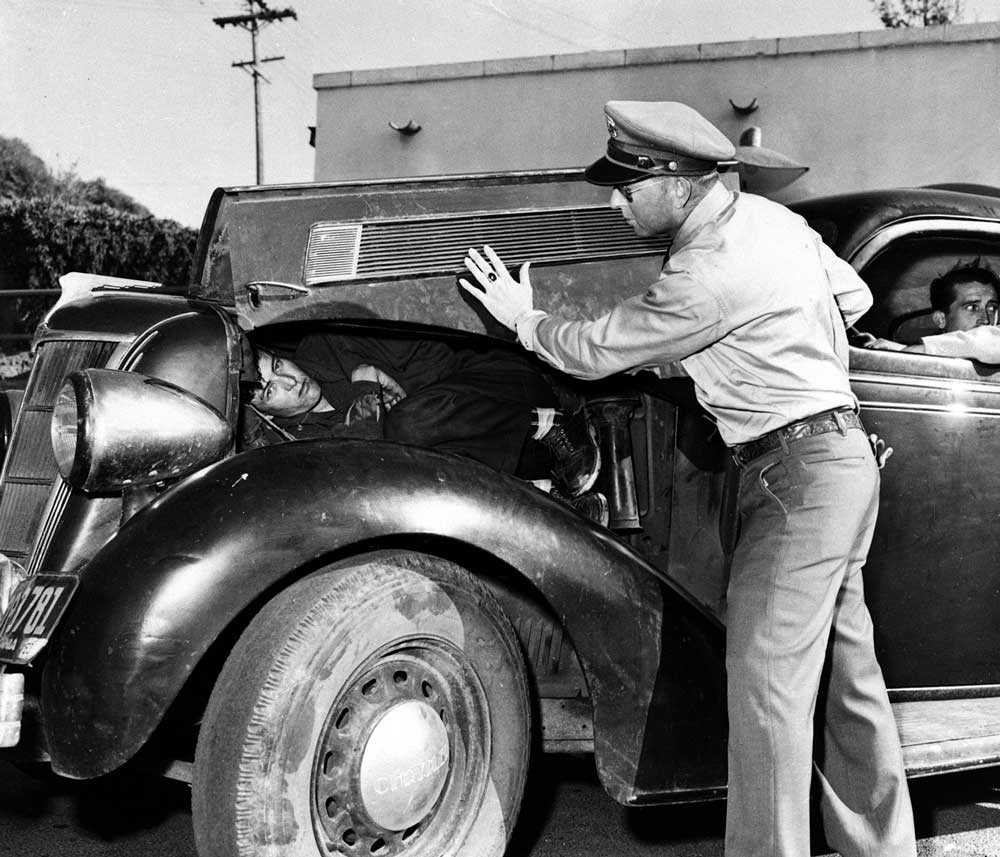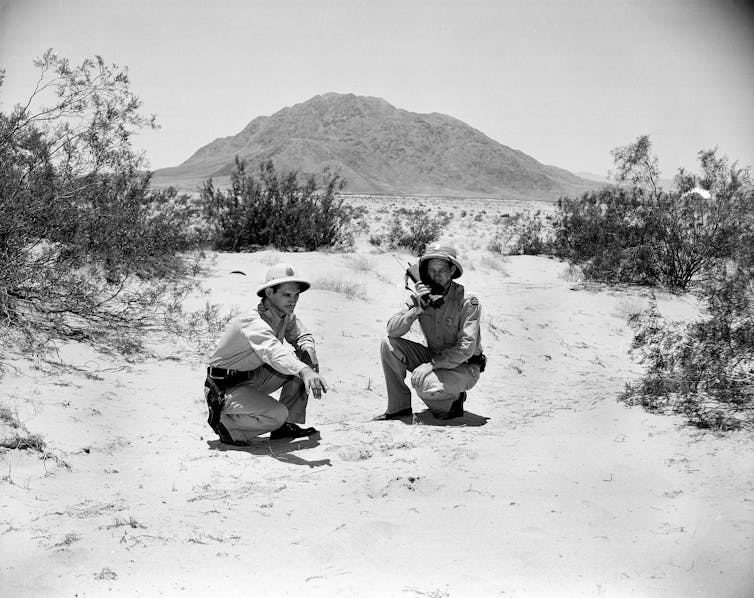
By Katrina Burgess
Katrina Burgess, Tufts University
While campaigning in Iowa last September, former President Donald Trump made a promise to voters if he were elected again: “Following the Eisenhower model, we will carry out the largest domestic deportation operation in American history,” he said. Trump, who made a similar pledge during his first presidential campaign, has recently repeated this promise at rallies across the country.
Trump was referring to Operation Wetback, a military-style campaign launched by the Eisenhower administration in the summer of 1954 to end undocumented immigration by deporting hundreds of thousands of Mexicans. “Wetback” was a widely used ethnic slur for Mexicans who illegally crossed the Rio Grande, the river dividing Mexico and the U.S.
Trump says that he can replicate Operation Wetback on a much grander scale by setting up temporary immigration detention centers and relying on local, state and federal authorities, including National Guard troops, to remove the estimated 11 million undocumented immigrants now living in the U.S.
As a migration scholar, I find Trump’s proposal to be both disturbing and misleading. Besides playing to unfounded and dehumanizing fears of an immigrant invasion, it misrepresents the context and impact of Eisenhower’s policy while ignoring the vastly changed landscape of U.S. immigration today.

Associated Press
Operation Wetback
In May 1954, U.S. Attorney General Harold Brownell appointed Joseph Swing, a retired general, to lead the Immigration and Naturalization Service, or INS, in a “special program to apprehend and deport aliens illegally in this country from areas along the southern border.” Until 2003, the INS was responsible for immigration and border control, now handled by multiple federal agencies, including Customs and Border Protection and Immigration and Customs Enforcement.
Swing ramped up a decade-long practice of using special task forces composed of INS agents who could be rapidly deployed where needed in order to locate and deport undocumented workers. The operation began in California and then spread to Arizona and Texas. INS agents set up roadblocks and raided fields, factories, neighborhoods and saloons where immigrants were working or socializing. The INS also built a vast wire-fenced security camp, according to the Los Angeles Times, in order to detain apprehended immigrants in Los Angeles before sending them to the border.
Captured immigrants were put on hot, overcrowded buses or rickety boats and sent to designated border crossings in Arizona and Texas, where they were forced to cross back into Mexico. Some found themselves stranded in the Mexican desert just over the border. In one incident, 88 migrants died of sunstroke before the Red Cross arrived with water and medical attention. Others were delivered to Mexican authorities, who loaded them onto trains headed deeper into Mexico.
By mid-August, INS agents had deported more than 100,000 immigrants across the U.S. Southwest. Fearing apprehension, thousands more reportedly fled back to Mexico on their own. Most of these immigrants were young Mexican men, but the INS also targeted families, removing nearly 9,000 family members, including children, from the Rio Grande Valley in August. There is also evidence of U.S. citizens getting caught up in the INS sweeps.
Operation Wetback wound down its operations a few months later, and Swing declared in January 1955 that “the day of the wetback is over.” The INS disbanded its special mobile task forces, and the deportation of undocumented immigrants plummeted over the next decade.
Not just about deportation
Operation Wetback made the headlines and disrupted countless lives, but it was more show than substance when it came to deportation.
The government’s claim to have deported more than 1 million Mexicans during the summer of 1954 does not stand up to scrutiny. The 1.1 million figure was for the entire fiscal year, which ended in June 1954, and a sizable share of these apprehensions were repeat arrests, sometimes in a single day. Moreover, over 97% of these deportations occurred without a formal order of removal. Instead, migrants agreed, or were coerced, to leave the country after being apprehended.
Despite Trump-like rhetoric decrying a “wetback invasion” across the U.S.-Mexico border, Operation Wetback’s main objective was not to remove Mexican immigrants but rather to frighten U.S. farmers, especially in Texas, into hiring them legally.
This tactic largely worked. A crucial but often overlooked detail about Operation Wetback is that it happened at the same time as the Bracero Program, a massive guest-worker program between the U.S. and Mexico. Between 1942 and 1964, U.S. employers issued over 4.6 million short-term contracts to more than 400,000 Mexican farm workers. Nearly three-quarters of these contracts were issued between 1955 and 1964 – after the INS carried out Operation Wetback.
Operation Wetback is unlikely to have led to a dramatic decline in undocumented immigration had Mexican workers not had a legal option for entering the United States. As one immigrant caught up in Operation Wetback commented, “I will come back – legally, if possible. If not, I’ll just walk across again.”
The INS explicitly recognized the connection between the Bracero Program and the decline in undocumented immigration in a 1958 report, stating that “should … a restriction be placed on the number of braceros allowed to enter the United States, we can look forward to a large increase in the number of illegal alien entrants into the United States.”
It is no coincidence that the lull in migrants illegally crossing the U.S-Mexico border after Operation Wetback did not last once the Bracero Program ended in 1964. Mexicans still had strong incentives to migrate, but now they had to do so without visas or work contracts, contributing to a steady increase in border arrests after 1965 that surpassed 1 million in 1976 and reached nearly 2 million in 2000.

Farm Security Administration – Office of War Information photograph collection (Library of Congress)
Real lessons
If he were to win the presidency again, Trump would have the legal authority to deport undocumented immigrants, but the logistical, political and legal obstacles to doing so quickly and massively are even greater today than they were in the 1950s.
First, most undocumented immigrants now live in cities, where immigrant sweeps are more difficult to carry out. The INS learned this lesson when Operation Wetback shifted from the largely rural Southwest to urban areas in the Midwest and Pacific Northwest in September 1954. Despite transferring hundreds of agents to these locations and using similar tactics, INS agents produced far fewer apprehensions as they struggled to find and detain immigrants.
Second, the U.S. undocumented population is much more dispersed and diverse than in the 1950s. Today, Mexicans are no longer in the majority, and nearly half of undocumented immigrants live outside the six major hubs for immigrants – California, Texas, Florida, New York, New Jersey and Illinois.
Third, most undocumented immigrants in the U.S. did not sneak across the border. An estimated 42% entered the country legally but overstayed a visa illegally. Another 17% requested and received a short-term legal status that protects them from immediate deportation.
Finally, mass deportations are likely to spark a more broad-based resistance today than happened in the 1950s. Once staunchly opposed to undocumented immigration, most labor unions and Mexican-American organizations are now in the pro-immigrant camp. Likewise, the Mexican government, which helped with Operation Wetback, is unlikely to allow massive numbers of non-Mexicans to be deported to its territory without the proper documentation.
Trump has not supported a way to provide undocumented immigrants with a legal alternative, which means that migrants will keep finding ways to cross illegally.
![]()
Katrina Burgess is Professor of Political Economy at the Fletcher School of Law and Diplomacy at Tufts University.




























Derrick Redder says
Never say never/
As brutal as it sounds , if Hitler rounded up and got rid of approx 11 million people in about four years back before all the technology today .
Pogo says
@Katrina Burgess
Because you say so?
The mob, with Trump on its shoulders, will use your ivory tower for firewood. Trump’s rank and file think a bibliography is something to do with Sunday school. See the example of Florida and Texas for the last 25 years.
You’ve heard of Florida and Texas — where all of this started, the laboratory (or Guernica, if allusion is more important than basic substance) for all its worst excess? While you’ve been keeping up with fashionable thinking, monsters have been doing what they always do, have always done — and will always do.
DaleL says
Citizen Trump has pledged, while on the campaign trail to carry out the largest domestic deportation operation in American history.
This is campaign rhetoric, pure and simple. As pointed out in this story, it would be logistically impossible to deport 11 million people and it would result in widespread resistance.
Mr. Trump says whatever he thinks will motivate people to vote for him. The majority of his followers are anti-immigrant. Trump is not constrained by the truth, sanity or reality.
This is the same guy who last Saturday praised the fictional serial killer Hannibal Lecter “as a wonderful man” before disparaging illegal immigrants. He is the same guy who wondered if injecting bleach into a person could cure COVID. He said magnets didn’t work in water. He claims that windmills cause cancer. It would be really funny if it weren’t so scary.
William Moya says
I agree, this is electioneering talk, in abundance these days from both parties, it’s part of “our democracy”.
Hippy says
What is funny is you believe he actually said “injecting bleach into a person would cure covid” and the fact you believe it is also scary. I could go on here but there is not need.
Yes there is political rhetoric in his words, and I am sure you agree that the puppet Biden is not saying and doing things that he thinks will get him elected.
However you have to admit that flow of people over the border entering illegally was much less during the Trumps rein. During the current administration the flow if illegal aliens walking over the border has become a flood and nothing is being done to stem that flow. It is being encouraged. People who enter illegally are treated better than our own citizens, including those who served their country. We let 22 a day commit suicide, we let them live and on the streets. Yet we put those who break our laws in hotels…. It is sad and this admin is doing nothing to help.
Would you feel better if it is called Operation Illegal Alien? We could also give them a participation trophy as we ship them back across the border so they can at least showed they tried.
DaleL says
April 23, 2020, Trump said with reference to disinfectants such as bleach: “And then I see the disinfectant, where it knocks it out in a minute. One minute. And is there a way we can do something like that, by injection inside or almost a cleaning.”
I believe it because he said it.
Source: https://www.snopes.com/fact-check/trump-disinfectants-covid-19/
Hippy says
No where does he say “injecting bleach into a person could cure COVID” like you said in your first post. You proved that in your second post. He does not mention bleach anywhere.
Even your Snopes link (really Snopes lol) does not mention bleach anywhere. Again, you now prove your yourself wrong a second time.
“U.S. President Donald Trump said, with regard to possible medical treatments for COVID-19: “And then I see the disinfectant, where it knocks it out in a minute. One minute. And is there a way we can do something like that, by injection inside or almost a cleaning.”
Laurel says
DaleL: Trump says stupid, irresponsible crap and his MAGA crowd keeps making excuses for it. Over and over again, ad nauseam. When you come up with logic, they turn away, or run out the door screaming!
Laurel says
So injecting disinfectants is okay. How about introducing light into the body?
Geez! Trump’s a real intellectual. Maybe the orange makeup is having an effect. He could at least bring it back to his ears.
Charles says
How come when Donald was President he didn’t do anything about immigrants then? How come when he was in office Mexico never paid for the wall like Trump promised. Why because he is all talk, he promises everyone the world but the truth is he is selfish and only does things that help him personally no one else.
Laurel says
Trump fubbed up immigration while he was President, and he would fub it up again. All talk, and no real plan. Children separated from their parents with no plan to reunite. Internment camps would be his preference. He is short sighted, and preaches to the limited. Sorry to say that, but if it weren’t true, his followers would reject his nonsense if they could only get past the garbled, rambling of a narcissist, and do a little research that isn’t biased.
Immigrants are here because companies hire them. Fact is, they will work much harder, and faster, for less money. We have all seen it, so to deny it is to pretend. No one, including Trump or Biden, will be able to stop it. The best thing to do is to find legal ways to allow these people to continue to work.
The Democrats and Republicans, together, had a strict plan, but Trump nixed it just so he could start his rambling crap again.
Pogo says
@”How come when Donald was President he didn’t do anything…”
Let’s start at the start…
“…The people who want to build a wall between the United States and Mexico can’t figure out how to turn on the lights at the White House, according to the New York Times.
“Aides confer in the dark because they cannot figure out how to operate the light switches in the cabinet room,” the Times reported Sunday. “Visitors conclude their meetings and then wander around, testing doorknobs until finding one that leads to an exit…”
“..,— Former Trump adviser New Jersey Gov. Chris Christie had planned an orderly transition similar to previous Republican presidents, but the plan was literally thrown in a garbage pail by a senior Trump aide. Instead, a strategy of releasing executive orders almost daily was adopted.
— The only family photo that Trump placed in the Oval Office is a picture of his father, real estate developer Frederick Christ Trump.” The son of Christ?! Oh, for gawd’s sake!
https://www.sfgate.com/politics/article/Report-Trump-team-baffled-by-White-House-light-10911729.php
You can bet your citizen’s arm tattoo number, things will be different this time; starting with an inaugural military parade (including the oath to Trump, recited en masse, by thousands of geese) as they march off to begin the, “…end of this American Carnage…” or some other branding bullshit name. The camps are already extant: college dorms are ubiquitous.
Laurel says
Pogo: Then, Trump will put out the Trump Bible, 2nd Edition, with the Constitution removed. Or, for 12 easy payments of $69.95, you can get a Presidential Shredder.
Land of no turn signals says says
Why not? 3 presidents before succeeded why not him?
Endless Dark Money says
Id rather deport the orange stain and his maggots. You cant have a continually growing economy without immigrants its impossible…..
Keep Flagler Beautiful says
Written by a “migration scholar.” LOL. And from a college whose before-aid tuition cost is more than $84,000 per year. How predictable. But she needn’t worry. Joe will forgive her student loan and she’ll find a job at the only place that won’t laugh at her degree: the federal government.